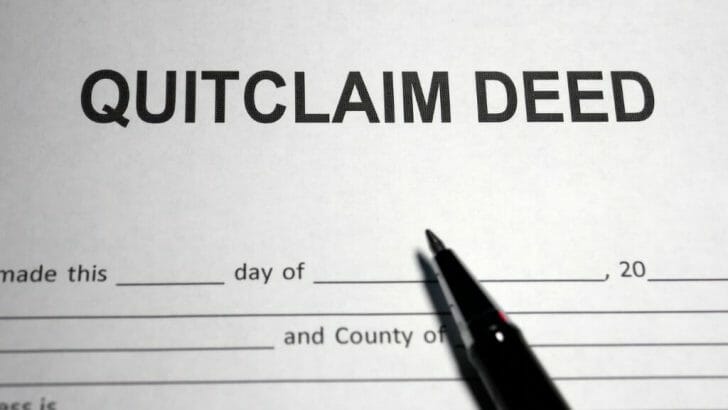A quitclaim deed sometimes referred to as a non-warranty deed is a document used to transfer interest in a property. Common terms utilized alongside quitclaim deeds are “grantor” and “grantee.” In this context, the grantor is the one transferring the ownership interest and the grantee is the one receiving it. For the most part, family members use quitclaim deeds to initiate fast real estate transfers. Consider speaking to a financial advisor if you need help drafting a quitclaim deed or managing other matters that involve the transfer of assets.
What Is a Quitclaim Deed?
To understand what a quitclaim deed is, it’s important to know what a general warranty deed is. A general warranty deed is the most common type of deed in real estate sales transactions. It is used to warrant the good state of the home title. This means it guarantees that the person transferring the title is the owner of the property and has the right to transfer the property to you.
With a general warranty deed, there is no one outside of the grantor (the person selling the property to you) who can claim the property as his or hers. It also guarantees that there are no debts or liens against the property except those that have already been made clear to the buyer. In other words, the deed provides the buyer with protection, or warranty, against those things.
By contrast, a quitclaim deed contains no warranties. All it does is transfer whatever interest the grantor has in the property over to the other person. There is no guarantee against the fact that the other owners have the ability to claim the property. And there’s no protection against debts and liens on the property. It’s even possible that the grantor does not actually own the property.
Being that a quitclaim deed looks to simplify the real estate transfer process, there are a plethora of different circumstances in which you can utilize one. Here’s a list of some of these situations:
- When transferring property to a child or another family member
- To pass on a property through your will
- When adding your spouse to the property’s title
- To remove your ex-spouse from the property’s title
- When transferring property to a business
How Does a Quitclaim Deed Affect Your Mortgage?
It is important to note that a quitclaim deed has no effect on a mortgage. A quitclaim transfers a property’s title but any mortgage the grantor has will not transfer. This is particularly dangerous if the grantor’s mortgage includes a due-on-sale clause, as the clause will require the grantor to pay the entire remaining balance of the mortgage once the title changes hands.
Even if the grantor assumes the grantee will take over mortgage payments, the grantor has no legal recourse if the grantee stops making payments. If you need to transfer a mortgage and you feel that a quitclaim loan is the best deed option, create a legal agreement stating that the grantee will take over the payments.
Should I Use a Quitclaim Deed?

In general, quitclaims are useful in situations where you want to transfer ownership (or someone’s claim to a property) without exchanging any money. Because of the lack of warranty, you should usually only use a quitclaim deed with someone you know and trust, like family members. For example, a parent who is moving to a retirement community may quitclaim his or her house to a child. This way the child gets the rights to the property. Presumably, the child already understands the condition of the house.
Other common situations for a quitclaim deed include when someone gets married or divorced. In those cases, a homeowner wants to add or remove a spouse from the title. As another example, let’s say you are buying a home and an ex-spouse of the grantor still has his or her name on the home title, even though only the grantor cares for the home. This is a case where you might ask the ex-spouse to sign a quitclaim to remove her title.
You may also use a quitclaim deed to clear a cloud on the title. This is a simple defect like an issue with wording or a misspelling.
How to Create a Quitclaim Deed
Quitclaim deeds are relatively simple documents, and you can create your own easily. With that being said, any deed is a legal document. Therefore it’s best to consult with an attorney who can draft your deed, or at least review it before signing.
If you prefer the DIY approach, there are many free quitclaim deed templates available online. They often come in PDF form, so simply download the PDF and print it. From here you can fill out the paperwork by hand. In some cases, the PDF may allow for typing, meaning you can fill out the blanks prior to printing it.
Any form you use should state that it is a quitclaim deed. Include the grantor’s name, the grantee’s name and the address of the property that the grantor is transferring. The deed must state that the grantor is quitting any interest in the property and transferring that interest to the grantee. Both parties then need to sign the deed with a notary public. Some states require a second witness.
To transfer the property officially, the grantee must take the signed deed to the title company, which issues a new property title with the grantor’s name changed to the grantee’s name. Then the grantee must bring the new title to the county clerk to record the transfer.
Bottom Line

A quitclaim deed is a way to transfer property from one person (the grantor) to another. With a quitclaim deed, the person issuing the deed gives up his or her claim on the property, whatever that claim may be. However, there are no guarantees to protect the buyer in case there are liens, debts or other issues with the property title. It’s best to accept a quitclaim deed only from someone you know and trust. A quitclaim is also a useful way to correct mistakes on a title or to change the names on a title without exchanging any money.
Tips for Buying a Home
- Talk to a financial advisor about how buying a home will factor into your larger financial plan. This is important, as you want to ensure you can purchase a home without sacrificing your other financial goals. SmartAsset’s free tool matches you with up to three vetted financial advisors who serve your area, and you can interview your advisor matches at no cost to decide which one is right for you. If you’re ready to find an advisor who can help you achieve your financial goals, get started now.
- Make sure that your credit score is in good shape. With a high credit score, you can get lower mortgage rates, which translates to lower monthly mortgage payments.
Photo credit: ©iStock.com/Hailshadow, ©iStock.com/RichLegg, ©iStock.com/gpointstudio
